KTree India IT Job Market 2023: A Comprehensive Analysis and Outlook
Dive deep into an illuminating exploration of India’s IT job landscape, spotlighting the vibrant array of opportunities spread across cities and tiers. Discover where the realms of innovation flourish, revealing the roles that stand in the limelight of the employment arena.

India IT Job Market 2023
In 2023, India’s IT job landscape is marked by a combination of both opportunity and challenge. Our survey unfolds an intricate narrative, revealing an array of job roles available across various cities, each with its unique offerings in the realm of technology. However, a significant change in hiring trends has been noted this year. Following the layoffs at major global players like Google in the US and similar downsizing trends in various other companies, there has been a cautious approach observed in the hiring strategies across the sector. Multinational software corporations in India have reduced their hiring activities. Initially, they are prioritizing job candidates who received offer letters in 2022, fulfilling previous commitments. We can see a noticeable decrease in the recruitment of fresh college graduates, showing a more conservative approach to entry-level hiring this year.
This report categorizes various cities into different tiers based on their standing in the IT job market landscape of India. Here is a breakdown:
Tier 1 includes the major cities like Bengaluru, Delhi, Hyderabad, Pune, Chennai, and Mumbai. These cities are the pillars of the IT industry, housing the majority of jobs and major tech companies.
Tier 2 encompasses cities such as Kolkata, Ahmedabad, Kochi, Jaipur, and Thiruvananthapuram. These cities are emerging strong, holding a significant share of IT opportunities and showing potential for growth and development in the sector.
Tier 3 comprises cities like Coimbatore, Indore, Mohali, Surat, Chandigarh, Vadodara, Nagpur, and Bhubaneswar, along with Thane. These cities are gradually making their presence felt in the IT landscape with a steady influx of opportunities.
Tier 4 includes several cities like Mysore, Mangalore, Nashik, Rajkot, Bhopal, Lucknow, Vishakapatnam, Vijayawada, and Warangal, among others. However, this report has chosen to exclude Tier 4 cities from the detailed analysis and discussion.
The classification aims to provide a clear perspective on the distribution of IT job opportunities across various cities in India, aiding in a nuanced understanding of the current IT job market.
Key Insights
The following key insights have been discerned from the comprehensive analysis of the IT job market in India, based on data meticulously collected from one of the leading job portals on a single day in October 2023:
Remote and Hybrid Work Opportunities: Only 1.8% of the total job offerings are entirely remote. Interestingly, Delhi NCR leads in remote work openings with 1.75%, closely followed by Bengaluru at 1.59%. Furthermore, the market shows that about 4.77% of jobs offer a hybrid working model, with Pune taking the lead with 7.23% of such roles, followed by Chennai and Bengaluru.
Geographical Distribution: Bengaluru continues to be the IT job hotspot, holding around 25% of the country’s IT job opportunities, followed by Delhi NCR at 14%, and Hyderabad at 13.5%. Notably, Pune surpasses Mumbai, holding approximately 12.25% of the IT jobs and ranking fourth in the country.
- Maharashtra: Leading the way from a state perspective, Maharashtra showcases a rich diversity of IT job opportunities across its cities. The state boasts two Tier 1 cities, Pune and Mumbai, and two Tier 3 cities, Nagpur and Thane, making it a substantial contributor to the nation’s IT employment landscape.
- Gujarat: Gujarat emerges as a notable player with Ahmedabad representing as a Tier 2 city, while Surat and Vadodara mark their presence in Tier 3, reflecting a dispersed distribution of IT opportunities across the state.
- Kerala: Kerala brings forth Kochi and Thiruvananthapuram, both seated in Tier 2 with impressive numbers in a very short period.
- Tamil Nadu: With Chennai’s robust presence in Tier 1 and Coimbatore making a mark in Tier 3, Tamil Nadu illustrates a comprehensive participation in the IT job market.
- Punjab: Punjab is trying to improve its position in the IT Industry with Mohali and Chandigarh in Tier 3.
Tier-wise Distribution: Tier 1 cities monopolize the job market with a staggering 84% of job openings, followed by Tier 2 cities holding around 10%, and Tier 3 cities accounting for the remaining 6%.
Job Roles: A significant number of job openings are for roles such as Developers, Full Stack Developers, and Data Scientists. The arena of Artificial Intelligence and Machine Learning (AI/ML) also has a substantial representation with around 1,000 job openings across India.
Caveats:
- It’s essential to note that the same job may be listed under multiple roles, potentially affecting the overall job count. Moreover, some roles or job openings in certain cities might not have been captured fully in this survey, implying that the actual number of opportunities could vary. Also, cities from other than Tier 1, Tier 2, and Tier 3 have been excluded from the report.
- This analysis is made by looking at job openings from a top job site in India. The job data was taken on a specific day in October 2023. The goal is to understand the different IT jobs available in various cities of India. The information helps to see the trends and popular job roles in the IT industry. By doing this, we aim to give a clear picture of the job opportunities and the main cities that are important for the IT sector in India.
This data-driven insight provides a nuanced understanding of the current trends, opportunities, and patterns in India’s IT job market, aiding stakeholders in making informed decisions and strategies.
| IT Job Role | All Over India | Tier 1 | Tier 2 | Tier 3 | ||||||||||||||||||||
| Total | Office | WFH | Hybrid | Bengaluru | Delhi NCR | Hyderabad | Pune | Chennai | Mumbai | Kolkata | Ahmedabad | Kochi | Jaipur | Thiruvananthapuram | Coimbatore | Indore | Mohali | Surat | Chandigarh | Vadodara | Nagpur | Bhubaneswar | Thane | |
| Software Developer | 51748 | 48789 | 469 | 2490 | 12189 | 7482 | 6983 | 6154 | 5059 | 4724 | 2141 | 1904 | 778 | 596 | 596 | 497 | 518 | 457 | 571 | 307 | 290 | 290 | 212 | 0 |
| Full Stack Developer | 18149 | 16748 | 317 | 1084 | 4634 | 2277 | 2449 | 2343 | 1852 | 1671 | 622 | 638 | 265 | 152 | 170 | 178 | 174 | 135 | 131 | 125 | 94 | 105 | 55 | 79 |
| QA Engineer/Tester | 10720 | 10084 | 168 | 468 | 2584 | 1438 | 1588 | 1528 | 930 | 916 | 418 | 456 | 168 | 124 | 112 | 108 | 76 | 78 | 54 | 60 | 82 | 0 | 0 | 0 |
| Business Analyst | 9955 | 9433 | 125 | 397 | 2235 | 1448 | 1386 | 1227 | 942 | 1127 | 342 | 236 | 120 | 183 | 79 | 52 | 181 | 100 | 65 | 78 | 49 | 50 | 0 | 55 |
| Ux And Ui Designer | 9207 | 8780 | 142 | 285 | 1990 | 1548 | 1058 | 897 | 776 | 1022 | 400 | 367 | 213 | 130 | 128 | 88 | 121 | 131 | 124 | 62 | 45 | 56 | 51 | 0 |
| Data Analyst | 8006 | 7493 | 123 | 390 | 2111 | 1365 | 1222 | 899 | 672 | 946 | 281 | 135 | 53 | 67 | 31 | 48 | 38 | 44 | 0 | 19 | 34 | 41 | 0 | 0 |
| Systems Analyst | 6119 | 5810 | 59 | 250 | 1473 | 881 | 821 | 813 | 652 | 715 | 226 | 121 | 75 | 45 | 35 | 58 | 0 | 44 | 0 | 55 | 40 | 23 | 0 | 42 |
| Data Engineer | 4226 | 3667 | 81 | 478 | 1247 | 567 | 706 | 599 | 428 | 352 | 161 | 47 | 21 | 17 | 32 | 21 | 0 | 14 | 0 | 7 | 0 | 7 | 0 | 0 |
| DevOps Engineer* | 4060 | 3673 | 90 | 297 | 1176 | 510 | 606 | 546 | 410 | 351 | 150 | 80 | 72 | 17 | 23 | 28 | 21 | 23 | 10 | 10 | 10 | 8 | 0 | 9 |
| Web Developer* | 3930 | 3809 | 58 | 63 | 675 | 754 | 340 | 331 | 327 | 501 | 201 | 175 | 80 | 80 | 0 | 54 | 67 | 70 | 95 | 49 | 57 | 37 | 37 | 0 |
| Project Manager | 3915 | 3736 | 39 | 142 | 857 | 611 | 452 | 507 | 390 | 473 | 148 | 139 | 52 | 33 | 40 | 38 | 20 | 27 | 29 | 20 | 25 | 25 | 0 | 32 |
| System Engineer | 3877 | 3713 | 29 | 134 | 1248 | 414 | 437 | 581 | 484 | 334 | 105 | 81 | 42 | 19 | 34 | 36 | 0 | 12 | 0 | 18 | 0 | 0 | 12 | 20 |
| SystemAdministrator | 3606 | 3338 | 55 | 214 | 952 | 498 | 516 | 478 | 314 | 418 | 153 | 57 | 25 | 24 | 30 | 20 | 0 | 24 | 0 | 23 | 0 | 0 | 34 | 40 |
| Product Manager | 3388 | 3065 | 239 | 85 | 1183 | 532 | 535 | 500 | 410 | 357 | 156 | 90 | 55 | 30 | 33 | 21 | 37 | 22 | 22 | 22 | 19 | 16 | 0 | 19 |
| Application Support Engineer | 3042 | 2905 | 33 | 104 | 808 | 480 | 405 | 378 | 265 | 355 | 84 | 56 | 21 | 18 | 19 | 37 | 9 | 25 | 12 | 18 | 18 | 15 | 0 | 19 |
| Solutions Architect | 2776 | 2537 | 41 | 198 | 819 | 378 | 408 | 373 | 273 | 285 | 95 | 34 | 22 | 22 | 16 | 14 | 8 | 11 | 0 | 15 | 7 | 0 | 0 | 0 |
| Systems Architect* | 2744 | 2609 | 36 | 99 | 730 | 401 | 344 | 332 | 277 | 318 | 85 | 65 | 24 | 14 | 19 | 25 | 14 | 12 | 14 | 22 | 23 | 0 | 11 | 14 |
| Database Administrator | 2149 | 2026 | 26 | 104 | 520 | 281 | 356 | 293 | 221 | 243 | 99 | 29 | 12 | 8 | 17 | 14 | 7 | 4 | 6 | 13 | 6 | 7 | 5 | 8 |
| .NET Developer | 1981 | 1736 | 50 | 195 | 330 | 294 | 287 | 234 | 224 | 202 | 57 | 114 | 42 | 34 | 33 | 22 | 20 | 19 | 23 | 31 | 0 | 0 | 0 | 15 |
| Network Engineer | 1723 | 1637 | 22 | 64 | 386 | 277 | 237 | 201 | 185 | 210 | 58 | 48 | 19 | 16 | 15 | 9 | 9 | 12 | 11 | 15 | 15 | 0 | 0 | 0 |
| Technical Support Engineer | 1405 | 1359 | 21 | 25 | 292 | 244 | 160 | 196 | 110 | 147 | 72 | 38 | 15 | 24 | 10 | 17 | 11 | 19 | 0 | 9 | 11 | 18 | 0 | 12 |
| AI/ML | 1315 | 1142 | 76 | 97 | 490 | 253 | 231 | 218 | 128 | 132 | 48 | 49 | 10 | 11 | 15 | 11 | 4 | 5 | 4 | 4 | 6 | 0 | 0 | 11 |
| Help Desk Technician | 1255 | 1176 | 20 | 25 | 286 | 246 | 158 | 202 | 112 | 142 | 71 | 35 | 0 | 0 | 1 | 0 | 0 | 1 | 0 | 0 | 0 | 0 | 1 | 0 |
| Data Scientist* | 1167 | 1067 | 10 | 90 | 395 | 167 | 155 | 140 | 106 | 104 | 47 | 15 | 3 | 5 | 7 | 4 | 4 | 5 | 0 | 4 | 0 | 2 | 0 | 4 |
| Cybersecurity Analyst | 1046 | 962 | 16 | 158 | 260 | 166 | 122 | 146 | 85 | 160 | 31 | 20 | 9 | 6 | 8 | 7 | 0 | 6 | 0 | 7 | 0 | 7 | 0 | 6 |
| Cybersecurity Engineer/Architect | 1010 | 928 | 14 | 67 | 259 | 163 | 122 | 144 | 86 | 162 | 30 | 20 | 9 | 6 | 9 | 0 | 0 | 0 | 0 | 0 | 0 | 0 | 0 | 0 |
| CTO | 785 | 764 | 4 | 17 | 215 | 134 | 127 | 94 | 50 | 83 | 27 | 16 | 3 | 7 | 3 | 7 | 3 | 3 | 0 | 7 | 3 | 0 | 3 | 0 |
| Scrum Master* | 770 | 733 | 8 | 26 | 189 | 104 | 107 | 104 | 80 | 84 | 24 | 21 | 10 | 7 | 8 | 7 | 3 | 6 | 4 | 4 | 3 | 0 | 0 | 5 |
| Technical Writer* | 748 | 682 | 43 | 23 | 244 | 118 | 145 | 103 | 83 | 52 | 38 | 22 | 5 | 7 | 9 | 4 | 6 | 5 | 0 | 9 | 0 | 0 | 0 | 0 |
| Principal Software Engineer* | 345 | 330 | 2 | 13 | 126 | 27 | 73 | 58 | 33 | 26 | 0 | 0 | 0 | 0 | 0 | 1 | 0 | 0 | 0 | 0 | 1 | 0 | 0 | 0 |
| CIO | 202 | 193 | 0 | 9 | 76 | 40 | 24 | 27 | 8 | 23 | 2 | 1 | 0 | 0 | 0 | 0 | 0 | 0 | 0 | 1 | 0 | 0 | 0 | 0 |
| CEO | 190 | 183 | 4 | 3 | 51 | 55 | 20 | 7 | 7 | 34 | 3 | 7 | 1 | 1 | 0 | 0 | 0 | 0 | 2 | 0 | 2 | 0 | 0 | 0 |
| MIS Manager* | 106 | 107 | 5 | 2 | 14 | 29 | 6 | 15 | 6 | 26 | 4 | 2 | 0 | 1 | 0 | 0 | 1 | 0 | 0 | 0 | 0 | 1 | 1 | 0 |
| Program Analyst/Manager | 87 | 83 | 0 | 4 | 19 | 13 | 12 | 14 | 12 | 7 | 8 | 1 | 0 | 1 | 0 | 0 | 0 | 0 | 0 | 0 | 0 | 0 | 0 | 0 |
| IT Director | 58 | 58 | 0 | 0 | 14 | 8 | 5 | 3 | 10 | 7 | 0 | 0 | 6 | 0 | 2 | 0 | 0 | 0 | 0 | 0 | 0 | 0 | 0 | 3 |
| Cloud Architect/Engineer | 5 | 2 | 3 | 0 | 2 | 3 | 0 | 0 | 0 | 0 | 0 | 0 | 0 | 0 | 0 | 0 | 0 | 0 | 0 | 0 | 0 | 0 | 0 | 0 |
| 165815 | 155357 | 2428 | 8100 | 41079 | 24206 | 22603 | 20685 | 16007 | 16709 | 6387 | 5119 | 2230 | 1705 | 1534 | 1426 | 1352 | 1314 | 1177 | 1014 | 840 | 708 | 422 | 393 | |
Let’s delve into the vibrant universe of India’s IT job landscape, spotlighting the Tier 1 cities like Bengaluru, Delhi, Hyderabad, Pune, Chennai, and Mumbai. These cities stand as powerhouses, buzzing with a wide spectrum of opportunities, from roles like developers to analysts, embodying the spirit of technological innovation and excellence.
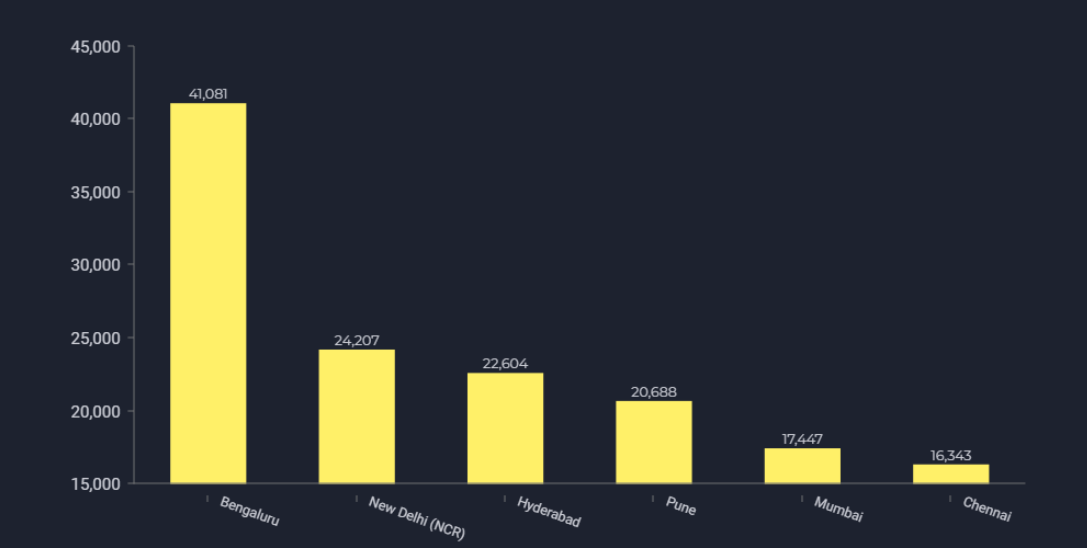
Top Tier 1 Destinations for IT Jobs in India
These cities aren’t just central to India’s IT storyline; they hold a whopping 85% of the country’s overall IT job opportunities. It’s a staggering testament to their significance in driving the industry forward, offering a world brimming with potential, diversity, and paths to success in the technological arena. So, if you’re on the hunt for vibrant opportunities and a place to make your mark in the IT sector, these Tier 1 cities roll out the red carpet, welcoming you to a realm replete with potential and promise!
Bangalore dominates with a 24% share of IT jobs in India, followed by Delhi NCR at 14%, Hyderabad at 13.5%, Pune at 12%, Mumbai at 10%, and Chennai at 9.5%.
Tier 2 cities like Kolkata, Ahmedabad, Kochi, Jaipur, and Thiruvananthapuram are becoming significant players in India’s IT job market. These cities contribute about 10% of the overall IT job offerings in India, showcasing themselves as vibrant and promising hubs for IT professionals.
They provide a strong competition to Tier 1 cities, especially in the digital sectors. Additionally, they offer more cost-effective employment solutions with lesser employee turnover, making them attractive prospects for businesses and job seekers alike. These cities are shaping up as essential pillars, supporting the dynamic structure of India’s IT employment landscape.
Kolkata is at the forefront, accounting for 3.85% of jobs, followed by Ahmedabad at 3%, Kochi at 1.34%, Jaipur at 1%, and Thiruvananthapuram at 0.92%.
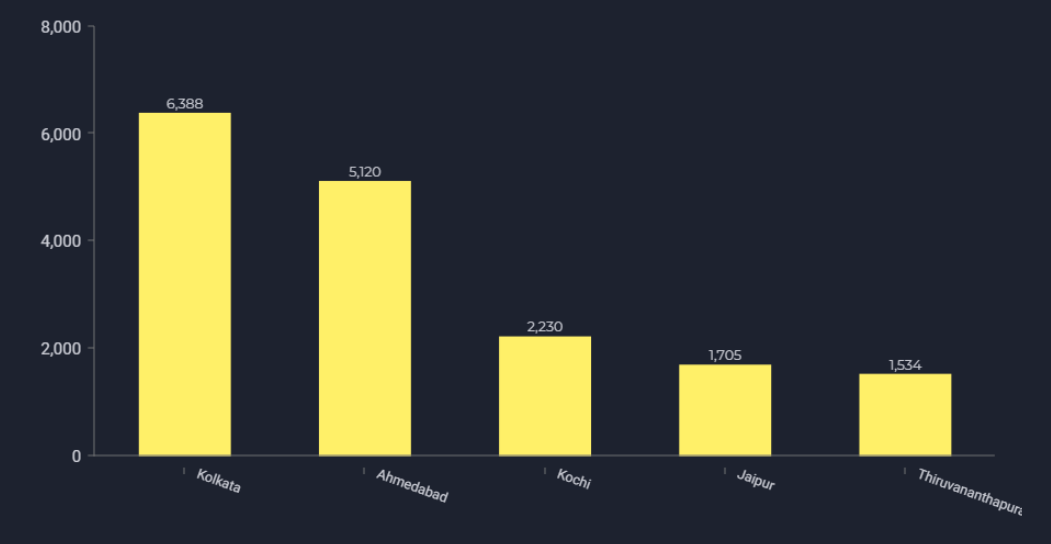
Top Tier 2 Destinations for IT Jobs in India
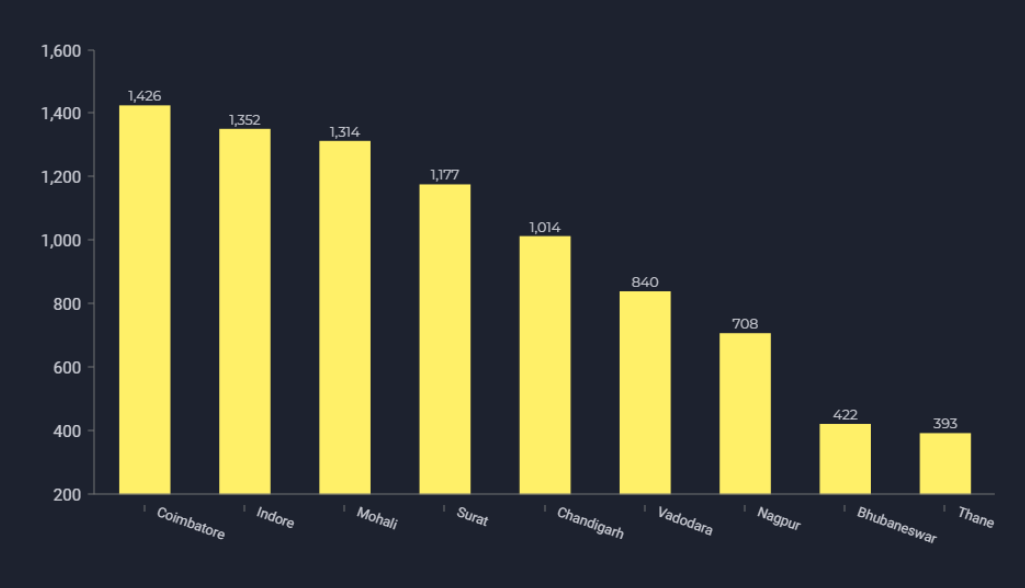
Top Tier 3 Destinations for IT Jobs in India
In Tier 3, cities like Coimbatore, Indore, Mohali, Surat, Chandigarh, Vadodara, Nagpur, Bhubaneswar, and Thane emerge as hubs of budding opportunities. Collectively, these cities account for 5.2% of India’s IT jobs. The distribution is as follows: Coimbatore holds 0.85%, Indore 0.81%, Mohali 0.79%, Surat 0.70%, Chandigarh 0.61%, Vadodara 0.50%, Nagpur 0.42%, Bhubaneswar 0.25%, and Thane 0.23%. These cities are carving niches as evolving grounds for IT employment in India.
Lastly, Tier 4 cities like Mysore, Mangalore, Nashik, Rajkot, Bhopal, Lucknow, Vishakapatnam, Vijayawada, and Warangal, though not the primary focus of this report, hold the essence of diversity and the seeds of future IT blooms. In this report, we concentrate on unveiling the IT job market’s vibrancy within Tier 1, Tier 2, and Tier 3 cities across India, where a plethora of opportunities flourish across varied roles. While Tier 4 cities like Mysore, Mangalore, Nashik, and others do embody potential growth arenas in the IT sector, they have not been included in our analysis, allowing us to focus on the regions with a more substantial concentration of IT job offerings.
The IT job market across various Indian cities unveils a dynamic interplay of work arrangements in 2023. Pune stands out with a leading 7.23% of jobs being hybrid and a substantial 0.98% dedicated to work-from-home (WFH) roles. Chennai follows suit in the hybrid category with 5.86%. Bengaluru makes a significant mark as well, showcasing 5.55% in hybrid roles and leading with a 1.59% in WFH positions. Hyderabad and Delhi NCR are also notable players in the hybrid work landscape, contributing 5.35% and 4.23%, respectively, with Delhi NCR also taking the forefront in WFH opportunities at 1.75%. Conversely, Mumbai appears more conservative in embracing flexible work arrangements, offering 0.87% in WFH and 3.09% in hybrid roles. This nuanced landscape reflects the diverse adaptations and strategic alignments of cities in navigating the contemporary realms of IT employment.
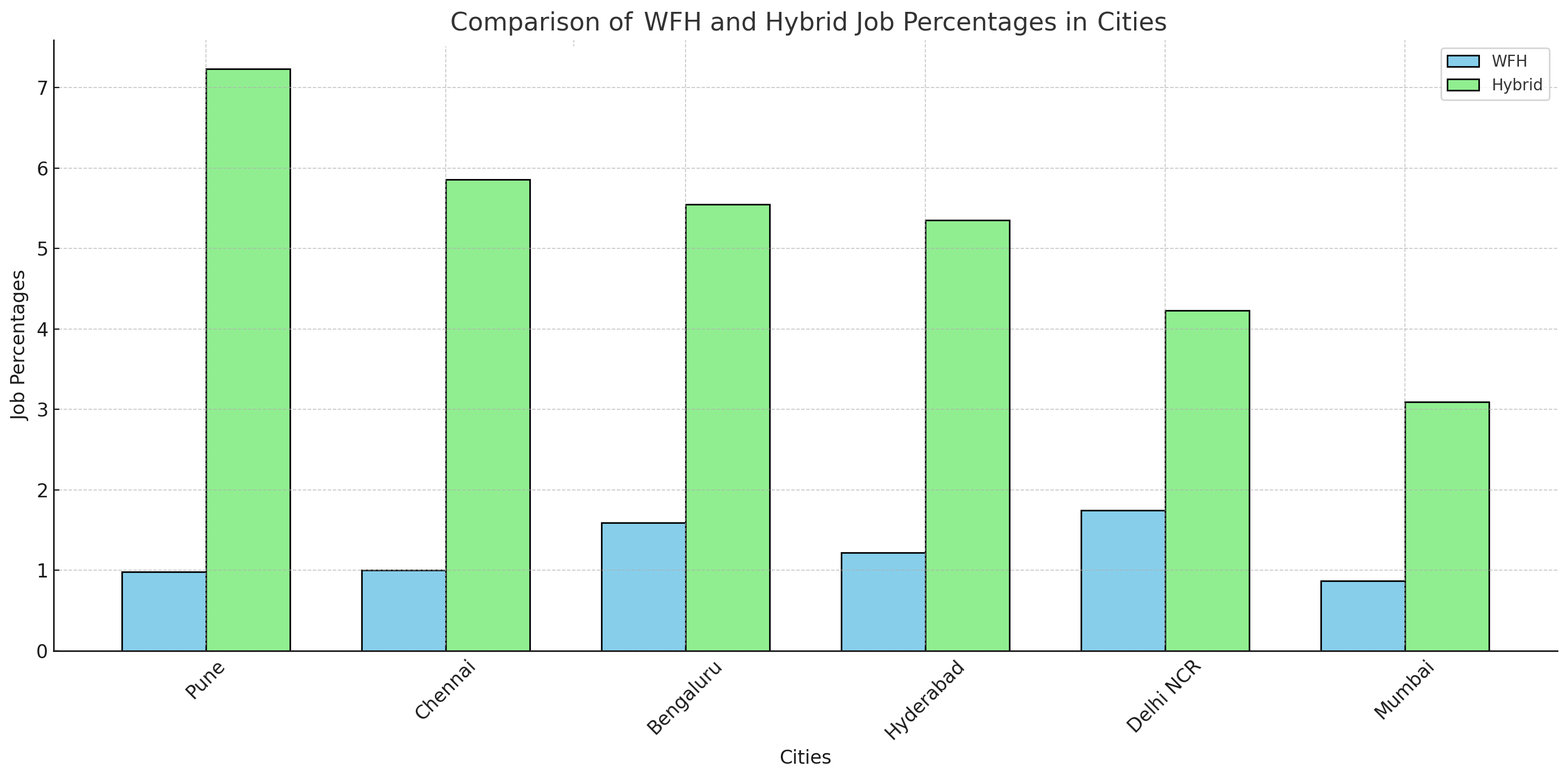
Best Cities for WFH and Hybrid Model
| Software Developer (Technology Wise) | All Over India Total |
| PHP Developer | 4153 |
| .net Developer | 1760 |
| Java Developer | 4468 |
| Python Developer | 1557 |
| SQL Developer | 905 |
| Node.js Developer | 768 |
| C++ Developer | 345 |
| Ruby Developer | 253 |
| C# Developer | 171 |
| Scala Developer | 51 |
| Perl Developer | 36 |
| Swift Developer | 33 |
| Go Developer | 29 |
| Kotlin Developer | 28 |
| TypeScript Developer | 22 |
| Rust Developer | 15 |
| Elixir Developer | 5 |
| R Developer | 5 |
| Erlang Developer | 1 |
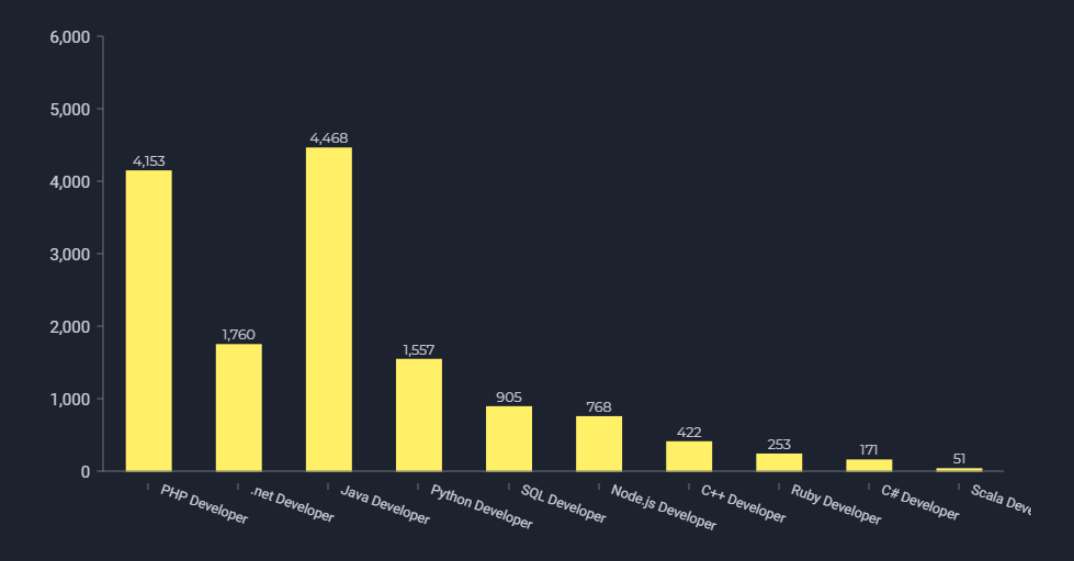
Top 10 Software Developer Job Opportunities in India- Technology wise Insights
A diverse array of opportunities is available for software developers specializing in various programming languages. PHP Developers currently have the most openings, with a total of 4153 positions available, closely followed by Java Developers who have 4468 job openings. .net Developers also see a significant number of opportunities, with 1760 job vacancies. Python Developers have 1557 positions available, while SQL Developers have 905 openings. Node.js Developers and C++ Developers have 768 and 345 openings, respectively.
Fewer positions are available for developers specializing in other languages such as Ruby (253 openings), C# (171 openings), and Scala (51 openings). The opportunities continue to decrease for Perl Developers (36 openings), Swift Developers (33 openings), and Go Developers (29 openings). Kotlin Developers have 28 openings, and TypeScript Developers have 22. Job openings are more scarce in languages like Rust (15 openings), Elixir (5 openings), R (5 openings), and Erlang (1 opening), reflecting the current demand for various programming languages in India’s IT sector.
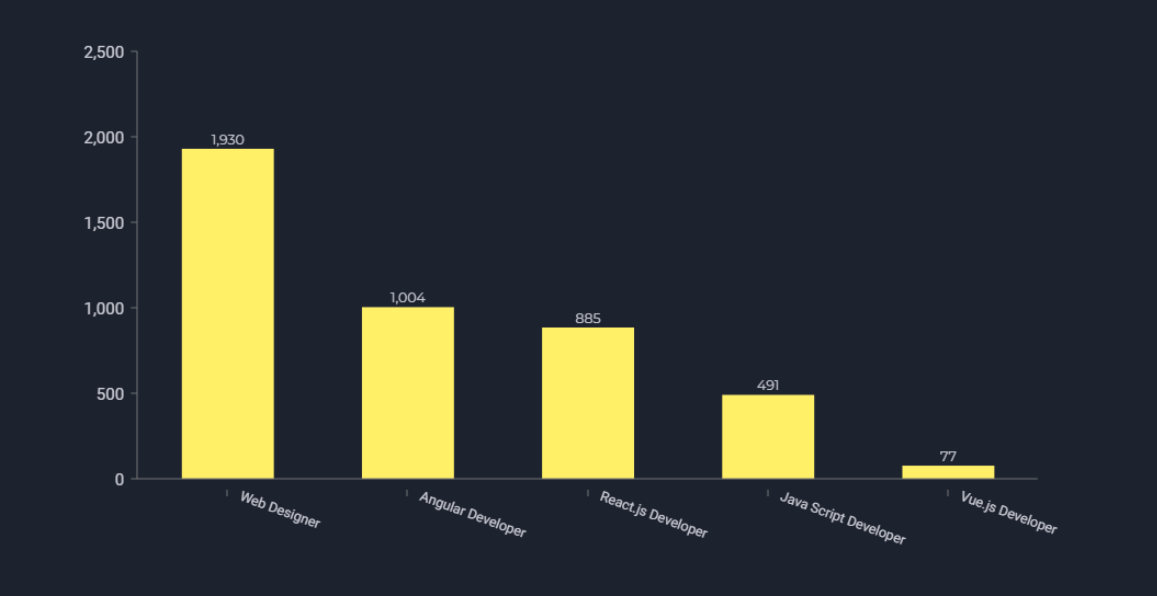
Top Front-End Developer Job Opportunities in India -Technology-wise Insights
In the realm of frontend development in India’s IT sector, there are various job openings catering to different specializations. Web Designers currently dominate the market with 1930 available positions. This is followed by Angular Developers who have 1004 openings, and React.js Developers with 885 available positions, showcasing a robust demand in these areas.
Java Script Developers also have a considerable number of vacancies, with 491 positions open. There is a notable drop when it comes to Vue.js Developers, who have 77 job openings.
| Frontend | All Over India Total |
| Web Designer | 1930 |
| Angular Developer | 1004 |
| React.js Developer | 885 |
| Java Script Developer | 491 |
| Vue.js Developer | 77 |
| HTML5 Developer | 24 |
| TypeScript Developer | 22 |
| jQuery Developer | 18 |
| Bootstrap Developer | 6 |
| CSS3 Developer | 5 |
In the landscape of job opportunities related to open-source products in India, there’s a diverse array of positions available, reflecting the richness and variability of open-source technologies. WordPress Developers are at the forefront, with 1026 job openings, underlining the popularity and widespread use of this platform. Following this, Laravel Developers are also in significant demand, with 687 positions available, showcasing its strong presence in the industry.
Magento and Drupal Developers are also sought after, having 377 and 189 openings respectively, pointing towards a consistent need for e-commerce and content management systems expertise. Other frameworks such as Django, Spring Boot, Liferay, and Flask also present notable opportunities, with Django leading among them with 118 openings.
| Open Source Products | All Over India Total |
| WordPress Developer | 1026 |
| Laravel Developer | 687 |
| Magento Developer | 377 |
| Shopify Developer | 202 |
| Drupal Developer | 189 |
| Django Developer | 118 |
| Spring Boot Developer | 78 |
| Liferay Developer | 44 |
| Flask Developer | 10 |
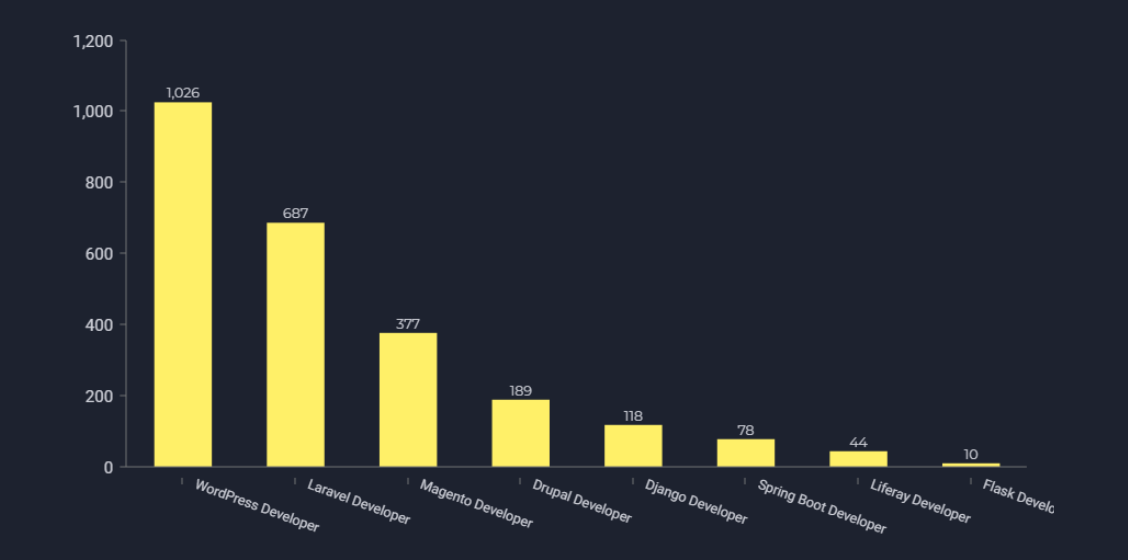
Top Open Source Products Job Opportunities in India – Technology-wise Insights
| ERP & Others | All Over India Total |
| SAP | 4909 |
| Netsuite | 140 |
| Oracle Financials | 238 |
| Odoo | 142 |
| Workday | 210 |
| Dynamics | 439 |
| SuccessFactors | 120 |
| Ariba | 120 |
| SalesForce | 1840 |
| SAS | 98 |
| BW & Data Warehousing | All Over India Total |
| SnowFlake | 271 |
| Tableau | 280 |
| Power BI | 142 |
| Business objects | 160 |
In the ERP and BW/DW sectors, a variety of job positions are currently available in the market, reflecting the demand for various technical specialties and platforms.
SAP roles are most prevalent with 4909 positions available, indicating a strong market demand for SAP expertise. SalesForce has 1840 positions open, highlighting its significance in CRM-related functionalities.Tableau has 280 positions, reinforcing its strong presence in data visualization.SnowFlake has 271 positions, showing its importance in modern data warehousing solutions.
In the realm of Mobile Development, different technology job openings are present, reflecting the diverse ecosystem of mobile technologies and platforms. The market is ripe with 2373 openings for Android Developers, underscoring the robust demand for experts adept in the widely used Android operating system. Following closely are iOS Developer positions, numbering 1429, indicative of the continuous allure of Apple’s ecosystem. Cross-platform development too is witnessing a boom, with React Native Developer roles tallying up to 783 and Flutter Developer positions reaching 597, highlighting the industry’s inclination towards versatile and multi-platform mobile applications.
| Mobile Development | All Over India Total |
| iOS Developer | 1429 |
| Android Developer | 2373 |
| Flutter Developer | 597 |
| React Native Developer | 783 |
| Xamarin Developer | 68 |
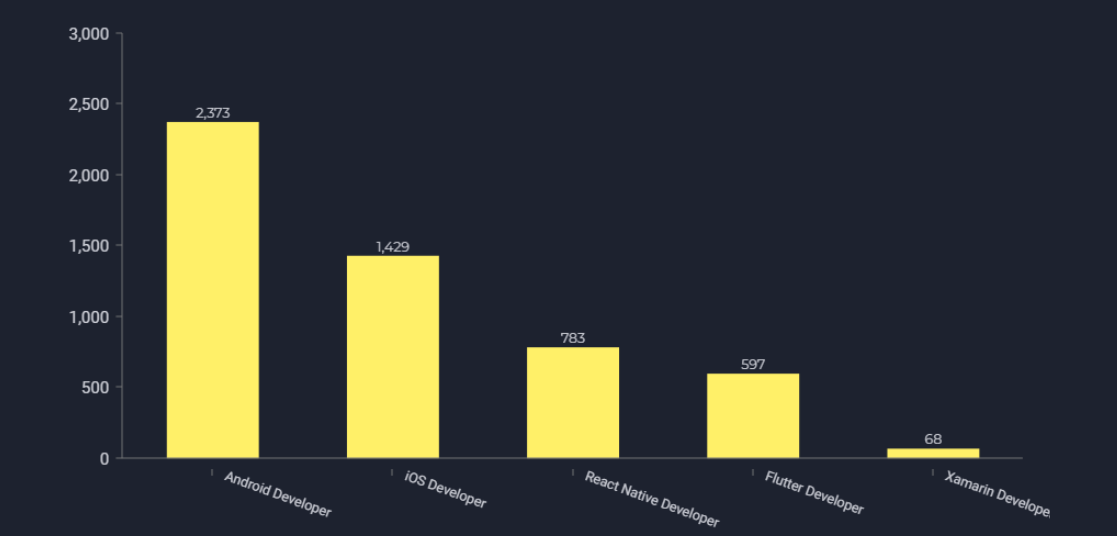
Top Mobile Development Job Opportunities in India – Technology-wise Insights
The IT job market in India is flourishing with a variety of roles that cater to different aspects of the technological landscape. Topping the list are Software Developers, with an astounding 51,748 job openings, reflecting the core essence of tech development across various industries. Full Stack Developers come in next, holding 18,149 positions, embodying the versatility required in today’s tech ecosystem. QA Engineers/Testers hold a strong position too, with 10,720 openings, ensuring the functionality and reliability of technological solutions.
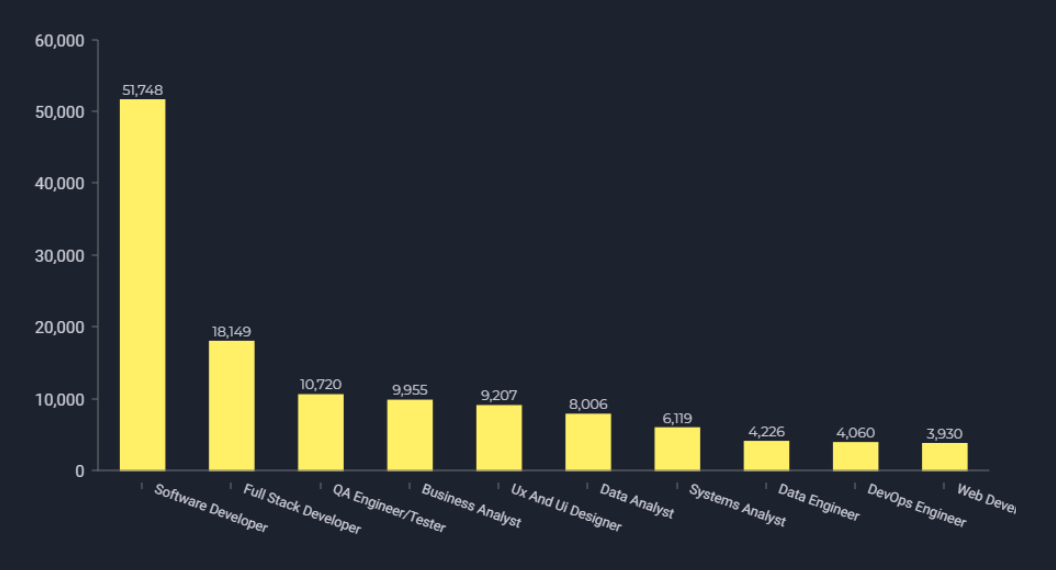
Top 10 IT Jobs Across India
Business Analysts, with 9,955 positions, play a pivotal role in bridging business needs with IT solutions, followed by UX and UI Designers who hold 9,207 positions, emphasizing the industry’s focus on user experience and interface design. Data Analysts and Systems Analysts also maintain a robust presence in the market, with 8,006 and 6,119 openings respectively, highlighting the significance of data and system analysis in contemporary IT roles.
Moreover, Data Engineers, with 4,226 positions, and DevOps Engineers, with 4,060 positions, underscore the importance of streamlined operations and data management in the IT infrastructure. Lastly, Web Developers maintain a steady foothold with 3,930 openings, reinforcing the continual relevance of web development in the digital realm. These roles collectively provide a comprehensive snapshot of the current IT job landscape in India, demonstrating the diverse opportunities available in the sector.
The “KTree India IT Job Market 2023 Report” provides a thorough insight into the IT job landscape across various cities in India. This year, the market exhibits a blend of opportunities and challenges, marked by a cautious hiring approach due to global layoffs and downsizing trends in significant tech giants. A multi-tier classification of cities is presented to depict the distribution of IT job opportunities, with Tier 1 cities, including Bengaluru and Delhi, leading the market.
A shift towards remote and hybrid work models is noted, although constituting a minor percentage of the total job offerings. The report further delves into various job roles, emphasizing developers and data scientists as highly sought-after positions. The geographical distribution of roles indicates a strong prevalence of opportunities in particular technologies and languages, such as PHP and Java, and a significant focus on areas like mobile development and open-source products. SAP roles also emerge dominantly in the ERP sector. In conclusion, this report offers a comprehensive perspective, aiding stakeholders in navigating and strategizing in India’s dynamic IT job market.
Note: Feel free to use any of the images or content from this report. However, we kindly request that you credit KTree or this URL as the source when doing so. Thank you for your cooperation and understanding.